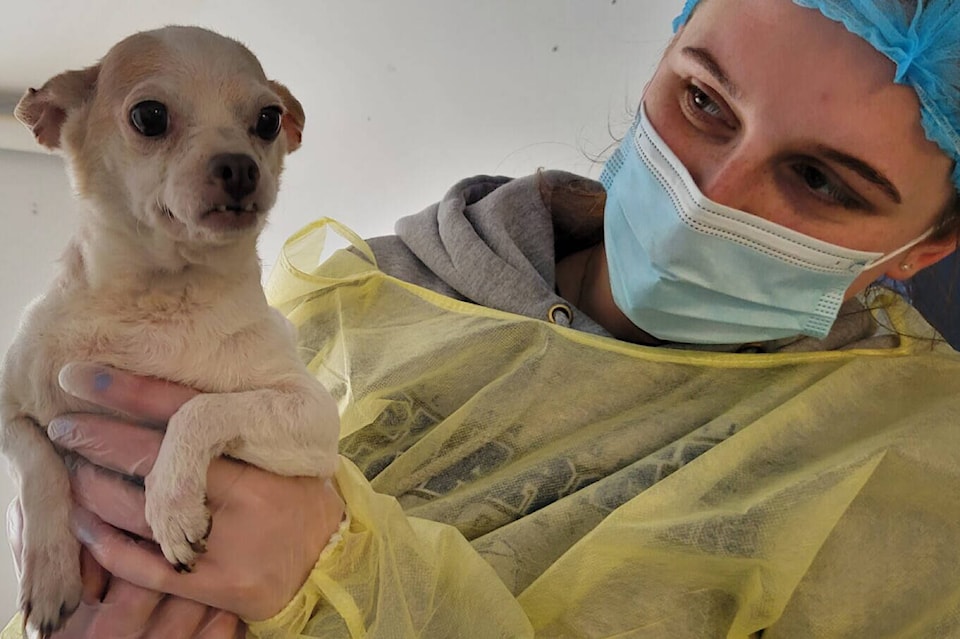Warning: This report contains details that can be upsetting to readers
The scene was bleak for BC SPCA staff as they seized 123 neglected animals from a trailer in Fort St. James. A staggering 120 cats and three small dogs were taken from the property, where they were being kept in “filthy and unsafe conditions in a trailer,” according to the BC SPCA.
On June 9 residents reported seeing 5 SPCA trucks and vans at a trailer park in Fort St. James as staff dressed in hazmat suits and breathing masks cleaned out a trailer. BC SPCA confirmed the incident in a June 14 interview.
In addition to the 123 animals from the Fort St. James property, 130 deceased cats were found in freezers behind a trailer where the same individuals had resided in Vanderhoof.
BC SPCA spokesperson Lorie Chortyk said they believe those same individuals moved the animals to Fort St. James in order to evade SPCA officers after the dead cats were found in Vanderhoof.
Chortyk said it’s an ongoing investigation and the BC SPCA will present evidence to Crown counsel who will decide whether charges are laid.
BC SPCA constables are sworn in under the police act with the authority to enforce laws relating to animal cruelty.
Many of the animals recovered in Fort St. James were described as emaciated and suffering from upper respiratory infections, extreme flea infestations, urine scald, eye infections, dental issues, ear mites and wounds.
Staff reported the entryway and hallway to the bedrooms were covered in layers of feces and the entire trailer was very hot and filled with an overwhelming ammonia smell due to the build-up of urine. The sticky layer of feces and urine covering the floors was so thick that boot covers were pulled off rescuers within only a couple of steps.
The majority of the cats were hiding in kitchen cupboards, under the fridge and under furniture in the sparsely decorated trailer. No water was present for any of the animals. Some dry cat food had been scattered on the floor, but the food was contaminated with urine and feces.
ALSO READ:
Many of the cats appeared very hungry and came up to the officer and immediately began eating the food that was offered. The animals were also having difficulty breathing as is common in these scenarios.
In addition to the cats, three chihuahuas were taken into care and are being treated for dental disease, hair loss and grooming issues, the BC SPCA said.
Chortyk said situations of animal hoarding are “very sad for the people, as well as for the animals” as animal hoarding is seen as a mental health issue.
“Our job as the SPCA is to make sure those animals are safe. But we cross-report with social service agencies, because these people need a lot of support as well,” Chortyk said.
“We try to be as compassionate and as non-judgmental as possible for the people as well as the animals but our first responsibility has to be to remove the distress of those animals and ensure they get the help they need.”
Often in hoarding cases the animals are fearful of humans and are in need of care before they can be adopted.
“It takes a lot of behavior modification, working with them to socialize them until they feel comfortable around people because they’re used to being with animals, but there’s not a lot of interaction with humans,” Chortyk said.
“We are just so glad that we were called in in time to rescue the remaining animals.”
Animal protection officers have seen an increase in large-scale cases like this in recent months, which Chortyk said puts a lot of pressure on resources as shelters are already busy.
“The day that this particular seizure took place… there were maybe five other cases with the large scale numbers,” she said.
“We always do get a large number of these cases, but it seems to have increased this year.”
Chortyk speculates that with COVID people might not have been going into other people’s homes and animal hoarding situations went unnoticed.
“These situations developed and now that things are opening up a bit more I think it’s more that these situations are coming to the attention of the public.”
The cats and dogs are being cared for at shelters and are receiving veterinary treatment. Chortyk said you can be a part of their rescue by donating toward their care.
READ MORE:
Do you have a comment about this story? email:
michael.willcock@terracestandard.com



